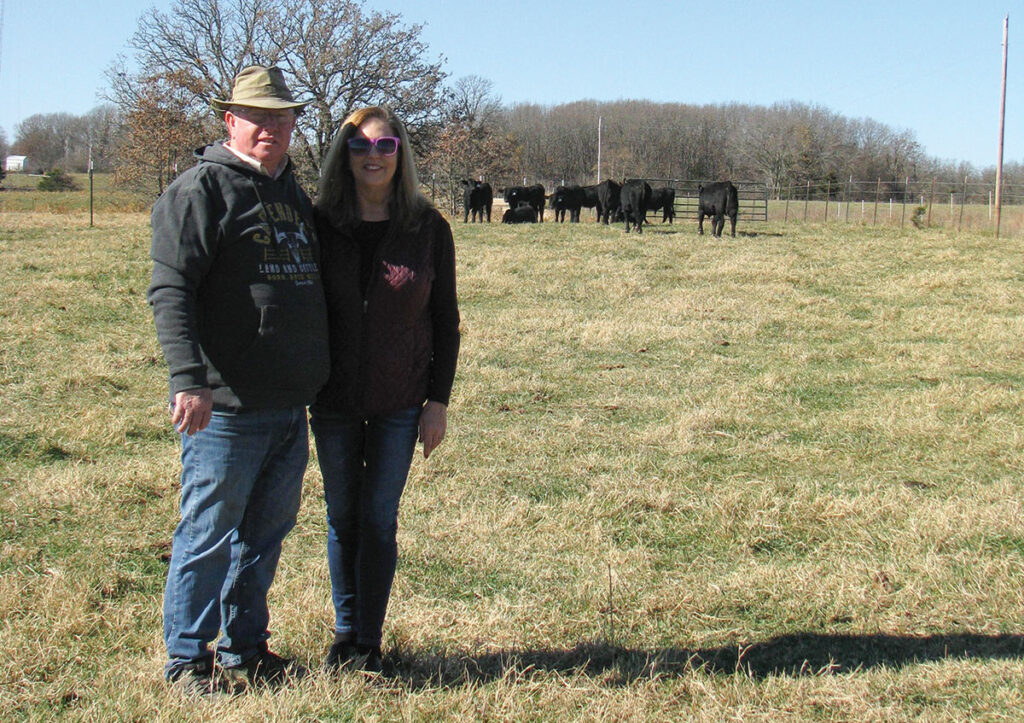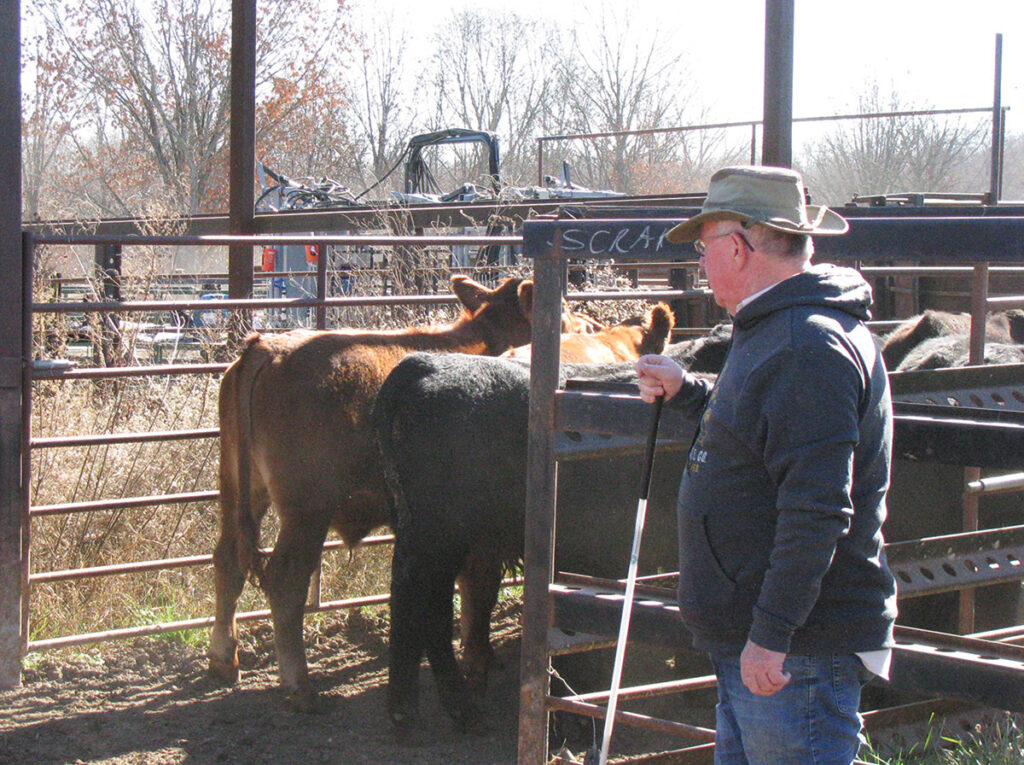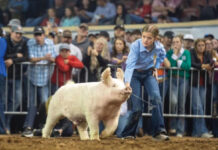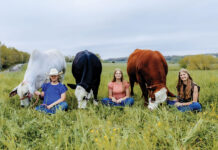
Through a “trap system,” Hampton Farms supports 900 head of cattle
HARTVILLE, MO. – On a 250-acre farm near Hartville, Mo., in Wright County, Dennis and Rhonda Hampton, their son Aaron and his wife Hannah run a unique cattle operation: Hampton Farms.
“It is run and managed by Aaron,” Dennis (his dad) said. Aaron and his family live near Marshfield, Mo. He drives to the farm every day to work.
Dennis works at Hutchens Industry and has for 46 years. Aaron works strictly on the farm. He gets to be his own boss.
“That is probably the biggest draw to the farming lifestyle. That’s one of the main reasons why I like it, because I don’t have to try to make somebody happy,” Aaron said.
Aaron and Dennis operate a “modified stocker operation.”
“We buy locally-sourced cattle,” Aaron explained. “We maximize the use of our grass along with a feeding program. This is not something you see every day. A lot of people start cattle and then send them to the feed yard, but they use a lot of grass or they put them in small pens, or they put them in the mud. We’re kind of in between there. We try to use the best of both worlds. The cattle have grass under them all the time and they utilize the grass very well, but we also feed the cattle.”
“We try to maintain 900 head all the time,” Dennis added. He also said they sell cattle monthly.
They maintain the cattle in what they call “traps.” The traps vary in size from 2 acres to 15 acres. The number of cattle per acre varies from four or five to 10 per acre.
“We have black cattle, red cattle, Charolais. We buy whatever we believe there’s value in or that we can add value to, to make money,” Aaron explained.
The Hamptons are in the “stock” market; buying low and selling high, hopefully.
They have no breeding stock. It is strictly calves. But it hasn’t always been that way. “There’s always been cattle on this farm,” Dennis stated. “I was born and raised on this farm. Four years ago, we finally got rid of all the beef cattle and we went to this modified stocker operation. So there’s always been cattle on this farm.”
The type of operation at Hampton Farms is not very common in the Ozarks. When they decided to start this type of operation there was no one to ask about it.
“I do know we’ve learned that we’re not going to take advice from people who don’t feed cattle or have data to back it up,” Aaron said.
“We’ve had to learn,” Dennis added. “We’ve taken data we collect weekly and with factual information you can improve your program. A lot of people don’t have enough facts to be able to manage.”
“They just do it the way grandpa or dad did it,” Aaron said.

Times have changed.
“We could do things like 50 years ago, when I was a kid. You could buy cattle without having to give them vaccines and various things. But in today’s environment, you have to utilize science,” Dennis stressed.
When buying a calf, they look for “something we can add value to,” Aaron said.
“In the agribusiness world, we’re trying to add a product that we can bring a high-risk calf in because somebody didn’t do all the homework they should have done in preparing that calf to go into a feed lot or to go into wheat pasture or something,” he added.
They are buying “higher risk calves,” predominately steers and bulls.
“We want to make them to be a package that the feed lots, the farmer feeders, the next people in the process can have that product and they’re ready to eat. They’re ready to perform,” Aaron said.
It is hard to buy weaned, castrated, vaccinated cattle and make money on them. “If they’re not weaned, or they’re still bulls, there’s a lot more risk because they’re at a higher stress,” Aaron explained.
“So we are buying the higher risk cattle that aren’t weaned, aren’t castrated, haven’t been vaccinated, and all those things. We’re trying to add the value to them plus make some money feeding them also,” Aaron said.
“They’re doing what a lot of the other people who buy their cattle don’t want to do. They don’t want the bawlers. They don’t want to deal with castration and all of that,” Rhonda said.
“We’re trying to fit a need in the market. So that’s what we’ve targeted,” Dennis stated.
The majority of the calves are only held for 60 to 90 days. Calves weigh between 675 to 900 pounds when they are sold.
“The goal is to put 200 pounds on them,” Dennis said.
Over the years, they have sold their cattle utilizing video sales and direct marketing. Currently, they are taking cattle back to the sale barn where most were purchased, Wright County Livestock
The Hamptons feed the cattle a commodity by-product mix.
“When we don’t have the grass, we’re feeding 3 percent on dry matter per body weight. That’s standard,” Aaron said. “When it comes to drought, probably doesn’t affect us like it does most people because we’re already feeding cattle. Yes, we probably fed more feed because in the springtime and the fall, if we get any rain the cattle utilize the grass that’s in their pasture or trap or pen that they’re in. That does reduce our feed costs and it’s substantial when you have this many cattle. That puts money in our pocket. It’s hard to calculate that, but it does. We got a good rain last year in August and we had a whole extra load of feed that we didn’t feed for five weeks. That adds up quickly,” Aaron explained.
“Because we bring all our inputs in, the cattle will eat that feed out of the bunk and they will fertilize the ground. So the soil will produce very well. It comes a rain and grass will jump,” Dennis added.
While the production method is working for the family, there’s always more to be done.
“We’ve gotten to a level now where we’re at capacity. There’s room for improvement on making more traps,” Aaron said. “Keeping the cattle segregated until they’re 45 days drastically improves our treatment rate. When you overseed that capacity continually, it amplifies the problems that you have,” he said. “There’s lots and lots of holes in the bucket, so to speak, in this particular division of agriculture.”
“The key to what we’re doing is probably the infrastructure,” Dennis said of their 30-trap system. “And that was the one thing that we were really naive about in the beginning. You won’t go many places with this much fence on it. These 250 acres has a lot of fence,” he stated.







